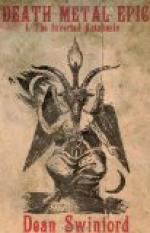Even the character of the hero varies from age to age, for whereas Charlemagne in the Chanson de Roland—which dates perhaps as far back as the tenth century—is a heroic figure, he becomes during later periods, when vassals rise up against their overlords,—an object of contempt and ridicule. A marked example of this latter style of treatment is furnished by Les Quatre Fils d’Aymon.[7]
The second group, or cycle of Brittany, animated by a chivalrous spirit, and hence termed court epic, finds its greatest exponent in the poet Chrestien de Troyes, whose hero Arthur, King of Brittany, gathers twelve knights around his table, one of whom, Mordred, is to prove traitor. The principal poems of this cycle are Launcelot du Lac, Ivain le Chevalier au Lion, Erec and Enide, Merlin, Tristan, and Perceval. These poems all treat of chivalry and love, and introduce the old pagan passion-breeding philtre, as well as a whole world of magic and fairies. These epics will be noticed at greater length when we treat of the English versions of Arthur and the Knights of the Round Table, because many of the poems have been reworked in modern English and are hence most popular in that language.
Besides the Chansons de Geste pertaining to various phases of this theme, the Breton cycle includes many shorter works termed lais, which also treat of love, and were composed by Marie de France or her successors. The best known of all these “cante-fables” is the idyllic Aucassin et Nicolette, of which a full account is embodied in this volume.
One of the best samples of the domestic epic in this cycle is the twelfth century Amis and Amiles, in which two knights, born and baptized on the same day, prove so alike as to become interchangeable. Still, brought up in separate provinces, Amis and Amiles meet and become friends only when knighted by Charlemagne, whose graciousness toward them rouses the jealousy of the felon knight Hardre. When Charlemagne finally offers his niece to Amiles (who, through modesty, passes her on to Amis), the felon accuses the former of treacherously loving the king’s daughter Bellicent, and thereupon challenges him to fight. Conscious of not being a traitor, although guilty of loving the princess, Amiles dares not accept this challenge, and changes places with Amis, who personates him in the lists. Because Amis thus commits perjury to rescue his friend from a dilemma, he is in due time stricken with leprosy, deserted by his wife, and sorely ill treated by his vassals. After much suffering, he discovers his sole hope of cure consists in bathing in the blood of the children which in the meanwhile have been born to Amiles and to his princess-wife. When the leper Amis reluctantly reveals this fact to his friend Amiles, the latter, although broken-hearted, unhesitatingly slays his children. Amis is immediately cured, and both knights hasten to church together to return thanks and inform the mother of the death of her little ones. The princess rushes to their chamber to mourn over their corpses, only to discover that meantime they have been miraculously restored to life! This story is very touchingly told in the old Chanson, which contains many vivid and interesting descriptions of the manners of the time.




